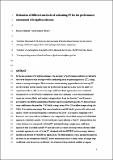Por favor, use este identificador para citar o enlazar a este item:
http://hdl.handle.net/10261/241332COMPARTIR / EXPORTAR:
 SHARE SHARE
 CORE
BASE CORE
BASE
|
|
| Visualizar otros formatos: MARC | Dublin Core | RDF | ORE | MODS | METS | DIDL | DATACITE | |

| Título: | Evaluation of different methods of estimating ET for the performance assessment of irrigation schemes |
Autor: | Salgado, Ramiro; Mateos, Luciano CSIC ORCID | Palabras clave: | Remote sensing Crop coefficients Vegetation index METRIC EEFlux |
Fecha de publicación: | 1-ene-2021 | Editor: | Elsevier | Citación: | Agricultural Water Management 243: 106450 (2021) | Resumen: | In the assessment of irrigation schemes, the accuracy of performance indicators related to the water balance could be improved by estimating crop evapotranspiration (ETc) using remote sensing techniques. The two main remote sensing approaches to estimating ETc are the surface energy balance and the FAO56-based approach, that uses the ability of vegetation indices (VI) to trace the crop coefficient. Both approaches were evaluated comparatively at the Río Dulce irrigation scheme in Argentina (where the predominant crops are cotton, alfalfa, and maize) using products from the Landsat 7 and 8 sensors provided by the EEFlux application. The first analysis used field-specific, VI-derived basal crop coefficients obtained for 1743 fields using series of 9–29 satellite images along the 2014−15 irrigation campaign. The second analysis used 30 fields (grown with cotton and maize) where the actual irrigation schedules in the 2014−15 irrigation campaign were known. A root zone soil water balance was computed in these fields using the FAO56 dual approach with field-specific, VI-derived basal crop coefficients. The ETc obtained from the water balance was compared with the ETc estimated using a single crop coefficient approach that uses field-specific VI and takes into account soil evaporation (herein called synthetic approach), and with the ETc obtained with the METRIC surface energy balance model as facilitated by the EEFlux application. The third analysis was a simulation analysis of errors in the estimation of the ETc due to the interpolation to daily values of single crop coefficients and basal crop coefficients determined at hypothetical satellite overpass intervals of longer than one day. The VI-derived basal crop coefficient curves obtained for the 1743 fields of the first analysis were below the locally adopted standard (not field-specific) basal crop coefficient. Crop evapotranspiration in the 8005 ha covered by this analysis was about 20 % higher when applying standard non-field specific curves than when applying VI-derived curves. This difference pointed to the importance of using field-specific estimations of ETc. In the analysis carried out on the 30 selected fields, the ETc estimated using the VI-based approach agreed well with the ETc obtained from the water balance except under water deficit conditions. The crop coefficients obtained for these fields using the METRIC model correlated with those obtained by applying the VI-based method, although the former tended to be higher than the latter in the lower value range. The analysis of interpolation errors showed that when satellite overpass frequency is greater than one week and water deficit is mild or inexistent, the interpolation of crop coefficients (for instance, of those derived from an energy balance) gives errors of ETc estimations that are greater than those resulting from the VI-based approach. Under water deficit conditions, the VI-based approach systematically overestimates evapotranspiration. | Versión del editor: | http://doi.org/10.1016/j.agwat.2020.106450 | URI: | http://hdl.handle.net/10261/241332 | DOI: | 10.1016/j.agwat.2020.106450 | Identificadores: | doi: 10.1016/j.agwat.2020.106450 issn: 0378-3774 |
| Aparece en las colecciones: | (IAS) Artículos |
Ficheros en este ítem:
| Fichero | Descripción | Tamaño | Formato | |
|---|---|---|---|---|
| AGWAT_2020_81_postprint.pdf | 809,88 kB | Adobe PDF |  Visualizar/Abrir |
CORE Recommender
SCOPUSTM
Citations
11
checked on 01-may-2024
WEB OF SCIENCETM
Citations
8
checked on 23-feb-2024
Page view(s)
75
checked on 03-may-2024
Download(s)
49
checked on 03-may-2024
Google ScholarTM
Check
Altmetric
Altmetric
NOTA: Los ítems de Digital.CSIC están protegidos por copyright, con todos los derechos reservados, a menos que se indique lo contrario.
